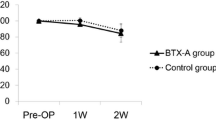Abstract
Elevated muscular tone associated with spastic syndromes can cause excessive contractility at the upper esophageal sphincter and impede swallowing. A 47-year-old male patient with spasticity predominantly of the lower extremities after a subarachnoid hemorrhage suffered from severe dysphagia and chronic salivary aspiration. He was dependent on a cuffed tracheostomy tube and a percutaneous enterogastric feeding tube. Barium swallow and esophageal manometry revealed cricopharyngeal spasm, while laryngeal elevation and pharyngeal contractility were well preserved. We endoscopically injected 180 MU botulinum toxin A into the cricopharyngeus muscle. Two days post injection, swallowing function had improved and oral nutrition was possible. This improvement lasted for six weeks. After another injection 8 weeks later, an undesired diffusion into the hypopharynx occurred and manometry showed diminished contractility without amelioration of dysphagia. Botulinum toxin therapy of cricopharyngeal spasm improves swallowing function in a subgroup of patients with spastic syndromes. The therapeutic effect is of limited duration. Toxin diffusion into the pharynx should be avoided. Manometry is useful in planning and monitoring the therapy.




Similar content being viewed by others
References
Clark HM. Neuromuscular treatments for speech and swallowing: a tutorial. Am J Speech Lang Pathol 2003;12(4):400–415.
Alberty J, Oelerich M, Ludwig K, Hartmann S, Stoll K. Efficacy of botulinum toxin A for treatment of upper esophageal sphincter dysfunction. Laryngoscope 2000;110(7):1151–1156.
Kahrilas PJ. Upper esophageal sphincter function during antegrade and retrograde transit. Am J Med 1997;103(5A):56S–60S.
Cook IJ, Dodds WJ, Dantas RO, Massey B, Kern MK, Lang IM, Brasseur JG, Hogan WJ. Opening mechanisms of the human upper esophageal sphincter. Am J Physiol 1989;257:G748–G759.
Schmid H, Wolfensberger M, Augustiny N, Brühlmann W. Cricopharyngeal myotomy in the dysfunction of the pharyngoesophageal sphincter. HNO 1987;35:425–429 [in German].
Laskawi R, Roggenkämper P. Botulinumtoxin-Therapie im Kopf-Hals-Bereich. Urban & Vogel Verlag, 2. aktual. und erw. Auflage, 2004.
Schneider I, Thumfart WF, Pototschnig C, Engel HE. Treatment of dysfunction of the cricopharyngeal muscle with botulinum A toxin: introduction of a new noninvasive method. Ann Otol Rhinol Laryngol 1994;103:31–35.
Moerman MB. Cricopharyngeal botox injection: indications and technique. Curr Opin Otolaryngol Head Neck Surg 2006;14(6):431–436.
Author information
Authors and Affiliations
Corresponding author
Rights and permissions
About this article
Cite this article
Krause, E., Schirra, J. & Gürkov, R. Botulinum Toxin A Treatment of Cricopharyngeal Dysphagia After Subarachnoid Hemorrhage. Dysphagia 23, 406–410 (2008). https://doi.org/10.1007/s00455-007-9132-1
Received:
Accepted:
Published:
Issue Date:
DOI: https://doi.org/10.1007/s00455-007-9132-1




